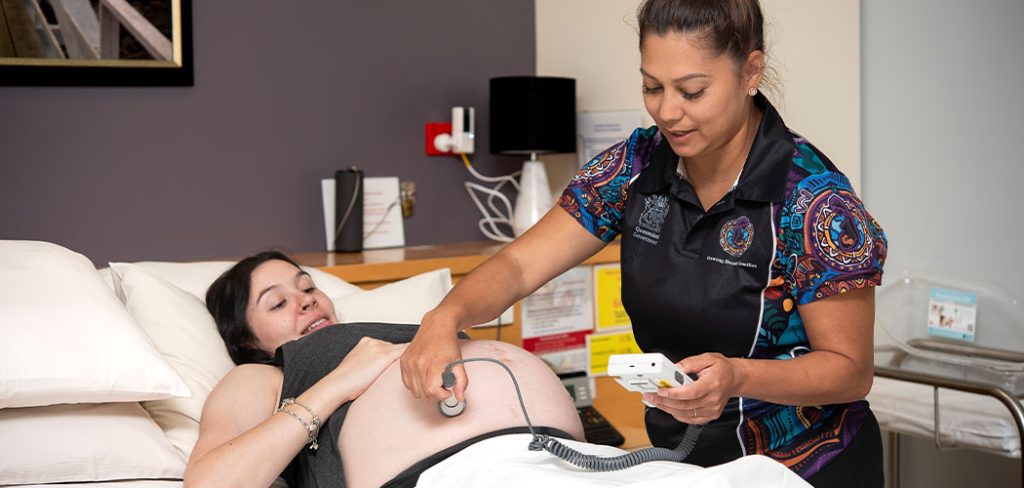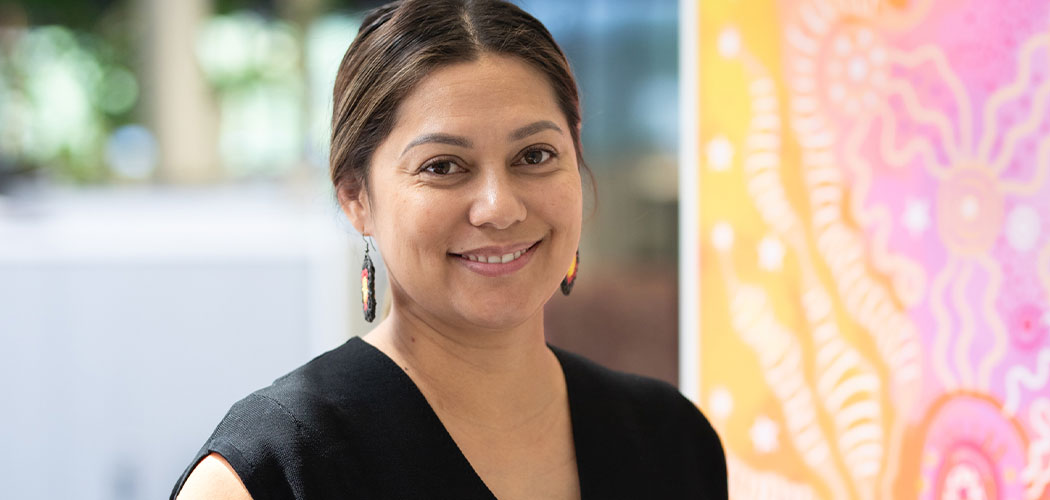Proud Gurindji woman and midwife Melina Connors has recently been appointed Queensland’s inaugural First Nations Midwifery Director, a historic first not only for Queensland, but for all of Australia. She talks with the ANMJ for International Day of the Midwife on 5 May.
What is the role of the inaugural First Nations Midwifery Director for Queensland Health?
As the First Nations Midwifery Director, I will also oversee the coordination and ongoing implementation, governance, and expansion of the Growing Deadly Families Aboriginal and Torres Strait Islander Maternity Services Strategy 2019-2025 (GDF Strategy) and other priority government initiatives.
I will provide support within the Office of the Chief Midwife to ensure there is cultural oversight and governance in the work they do.

You’ve been advising the government on the Growing Deadly Families Strategy, is this an extension of that work or much broader?
In my previous role as a clinical midwifery coordinator, I worked alongside Sonita Giudice who is also a First Nations Midwife. Together, we were responsible for Growing Deadly Families deliverables and supporting the co-design process of maternity models between Hospital Health Services (HHS) and Aboriginal and Torres Strait Islander Community Controlled Health Services (ATSICCHS).
Our responsibilities as Aboriginal women is always to First Nations communities, to represent the needs of women, their families and the broader community. This role is to demonstrate how this strategy and its outcomes are being expanded with the goal of ensuring all First Nations families have access to maternity care that is culturally aligned.
We will expand Growing Deadly Families over this next period, and it is very exciting to see that we are recognising the need for First Nations governance of that work.
Can you tell us a bit about yourself and your passions in your professional career?
I am a proud Gurindji woman, born in Darwin. Brisbane has been my home for a very long time. I’m a mother of three daughters and a Mimi to two beautiful grandchildren.
My journey into midwifery came about from my own maternity and birthing experience. My cultural needs weren’t factored into the midwifery care I received. I think that’s the moment when midwifery chose me.
The only way I truly felt I could make a change in maternity services for Aboriginal and Torres Strait Islander women was being in it.
Being part of driving the change so that all Aboriginal and Torres Strait Islander women felt culturally safe and could feel confident in knowing that when they are going through their pregnancy journey, that they will receive care from culturally capable staff and a culturally safe service where they don’t have to question whether their cultural needs were met.
My mentality used to be that if my practice and support could impact one Aboriginal and Torres Strait Islander woman than that would be enough. But in hindsight, it was never enough; it must be all Aboriginal and Torres Strait Islander women.
Previously, I worked as a clinical midwife in a tertiary hospital. In 2018, I was fortunate enough to hold a dual position and work as an Aboriginal and Torres Strait Islander Liaison Officer. Working in this space gave me great insight into the complete journey Aboriginal and Torres Strait Islander people face in order to receive health care.
This position served any Aboriginal and Torres Strait Islander person seeking services in this tertiary facility, and they could be coming from anywhere in Australia. It gave me an appreciation of navigating the healthcare system from every aspect and supporting mob while they were receiving care in hospital and coordinating with a range of teams and multi-disciplinary services, so they could return home and continue to receive the care they need in the community.
In 2021, I began working as a Clinical Midwife Consultant on the GDF Strategy. This allowed me to work in a space that I am so very passionate about. It was why I became a midwife in the first place – to be part of co-designing maternity services driven by the voices of each community and partnered with local community Aboriginal & Torres Strait Islander Community Controlled health services.
As much as I enjoyed working in this space, I knew for me this wasn’t enough. My brain would be ticking over how we could grow our workforce. How could we role model to our young ones so that we were inspiring future midwives, health workers, nurses, allied health professionals? How do we create leadership roles?
When the First Nations Midwifery Director position was announced, I saw this an opportunity to be able to start making those changes.
What are your first priorities in the role?
I will continue to oversee the ongoing implementation of the GDF Strategy and the expansion. I will continue to provide cultural and midwifery expertise to support the HHSs and ATSICCHS in the codesign of midwifery led models of care, to drive health equity and support the cultural needs of First Nations families.
Within this role, I am able to take on more of a leadership focus and will be working with the Chief Midwife to drive change under the GDF Strategy. I am passionate about growing the First Nations workforce and that is a priority under Growing Deadly Families – in a way ensuring there are many other midwives to follow on from me.

How do you see your appointment impacting the health of Aboriginal and Torres Strait Islander women, families and babies?
A person from the community said to me that she was so thankful to still be around to see this position for Aboriginal and Torres Strait Islander people created.
When I told my family of my appointment, one of my daughters, who wants to be a nurse, responded with “thank you mum, thank you, to you and Rosie (The First Nation Nursing Director in the Office of the Chief Nurse Officer), thank you for creating these pathways for me”.
I understood the enormity of this position, but those comments really brought it home for me. This position itself has already impacted Aboriginal and Torres Strait Islander people.
The GDF Strategy visions that “all Aboriginal & Torres Strait Islander babies in Queensland are born healthy into strong resilient families” with the aim “to ensure every woman in Queensland giving birth to Aboriginal and/Torres Strait Islander babies, has access to high quality, clinical and culturally capable maternity services”.
One of the priorities of the GDF Strategy is continuity of carer. Women and families have told us, “We don’t want to keep telling our same story to different people”.
First Nations women deserve a choice in their maternity care. A continuity of carer model with a midwife allows them to build a trusting, respectful, and supportive relationship. It’s important no one has to tell their story over and over.
It is extremely well known that midwifery continuity of carer models provides superior outcomes for women and their infants. The risk of preterm birth, a major contributor to mortality and morbidity, is halved when First Nations women receive care from a known midwife.
Data from the currently funded GDF sites indicates that women are attending five or more antenatal appointments, that babies are being born in healthy weight ranges and a reduction in preterm birth rates.
My position will continue to drive culturally safe maternity care for Aboriginal and Torres Strait Islander women, families and babies from preconception into the first 2,000 days so that our babies have a better start to life.
As Jody Currie stated in the GDF Strategy, “supporting healthy mothers to have healthy births provides our children with their best chance to flourish, and that can truly change their life trajectory”.
The impact this position will have, is that there is no slowing down now.
What do you see the main challenges?
In Queensland, there are currently only 64 Aboriginal and Torres Strait Islander midwives, so one of the challenges is immediate solutions to workforce.
In order to address these workforce challenges, our office has developed a First Nations Nursing and Midwifery Workforce Strategy, under the leadership of our First Nations Nursing Director.
The Strategy articulates the key priority areas and investments needed to grow the workforce so that we can ensure we meet the needs of the community, now and into the future.
The GDF is currently working with other stakeholders to provide scholarships and cadetships to First Nations student midwives and nurses.
Currently, women and families are still being displaced when having to birth away from home for extended periods of time.
There is still institutional racism within services. Women and families are still experiencing this.
Services still aren’t collaborating and partnering with key stakeholders to codesign maternity services.
What are some of the solutions you see for midwifery care in regional and remote Queensland?
Enhancing pathways so that people can study in community and become midwives and then use those skills to continue to provide care on country is a great way to ensure the future of midwifery care in the regions.
Grow Your Own workforce solutions, where students have the opportunity to gain work experience in community and obtain qualifications without having to leave community for extended periods of time, instead of always depending on a fly-in/fly-out workforce.
The universities are doing some great work in this space, and Queensland Heath is working to provide cadetships that strengthen pipelines into midwifery.
Models of care that are co-designed with the community, ensuring solutions are truly community-led and driven.
This goes hand-in-hand with addressing institutionalised racism and building cultural capability within the system and workforce.
Will this role give you an opportunity to advocate at a national level/have a voice nationally representing QLD?
From what I understand, this role is a historic first, not only for Queensland, but for all of Australia.
My voice will always echo and advocate for the needs of the community and Aboriginal and Torres Strait Islander midwives.
By creating this position, we have set the bar for what we expect to see in terms of First Nations leadership within the field.









One Response
Well done Melina!
Your achievements are a testament to your unwavering dedication and love for our people. Your passion and hard work inspire us all to strive for greatness. Congratulations on your incredible accomplishments, and thank you for being a beacon of hope and empowerment for the First Nations community and our future generations. Keep shining brightly and making a difference every day.